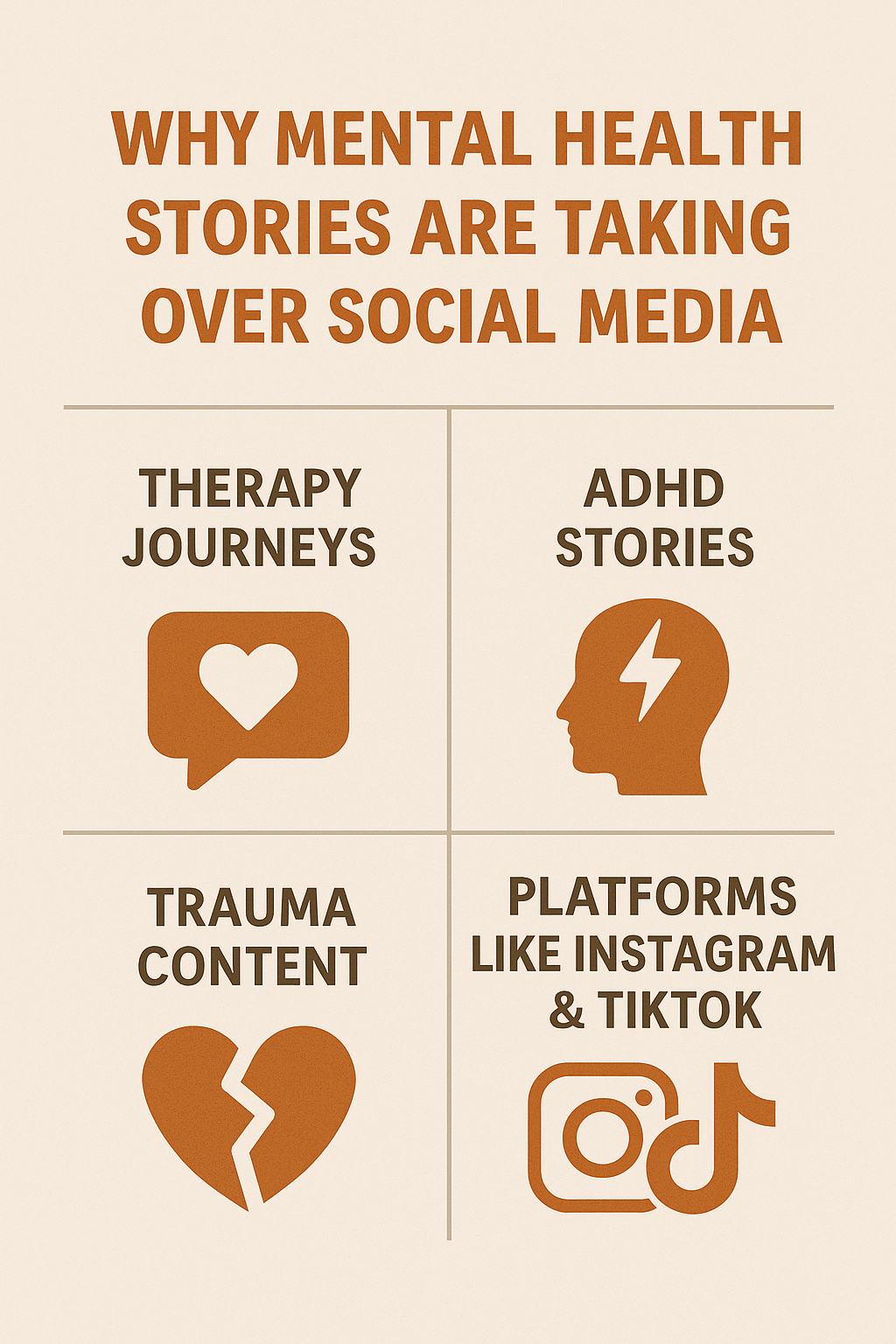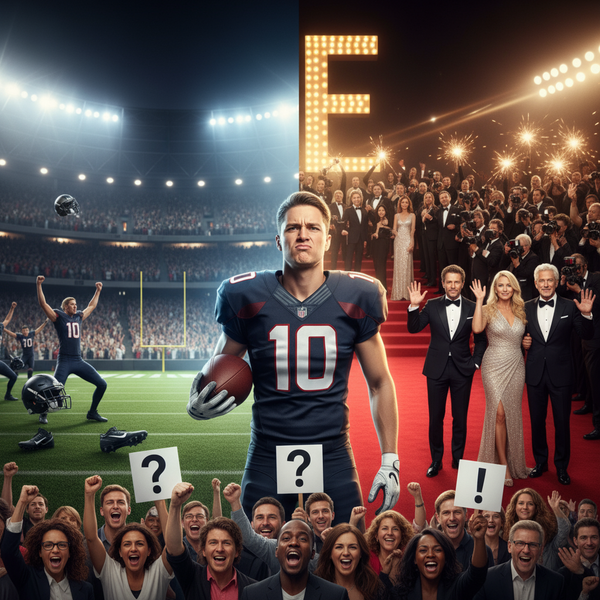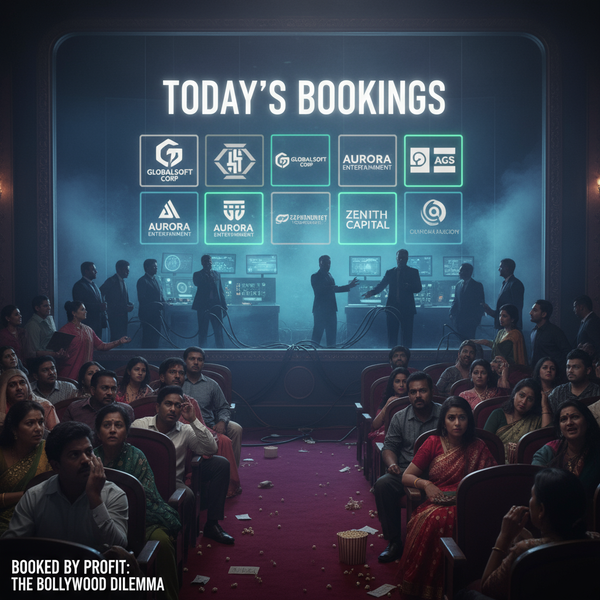Why Mental Health Stories Are Taking Over Social Media

Scroll through your TikTok feed or Instagram Reels, and you’ll see it: people talking openly about therapy, ADHD, trauma, anxiety, and healing. Not in hushed tones or academic jargon — but in real, raw, personal stories.
This isn’t a niche anymore. Mental health storytelling has become a digital phenomenon — a full-blown cultural shift. From teary car confessions to guided somatic exercises, content creators are making space for emotions, vulnerability, and inner work in a way the internet hasn’t seen before.
In 2025, these stories aren’t just trending — they’re transforming lives, driving conversations, and redefining what “influence” really means.
From Taboo to Timeline: The Evolution
It wasn’t long ago that mental health was largely private. Therapy was whispered about. Trauma was carried, not shared. Social media was a highlight reel — polished, pretty, performative.
But something changed.
COVID-19 cracked the illusion. Suddenly, everyone was anxious, grieving, isolated. The internet became a space to make sense of it all. And into that void poured creators, therapists, and everyday people documenting their inner worlds.
What started as scattered vulnerability became a wave — millions now use platforms to talk about their diagnoses, healing journeys, nervous system regulation, and lived experiences.
The shift isn’t just anecdotal — mental health hashtags now rack up billions of views. Instagram’s “ADHD Reels” and TikTok’s “#TherapyTalk” are algorithm magnets. What was once hidden in journals is now front and center on screens.
Why Is This Happening Now?
Several cultural and technological factors converged to create the perfect storm:
1. Burnout & the Post-Pandemic Reckoning
The collective burnout post-2020 forced people to re-evaluate priorities. Hustle culture lost its shine. Quiet quitting, digital detoxes, and self-care took its place.
People didn’t want another productivity hack — they wanted to feel better, and to be seen.
2. The Rise of Neurodivergent Voices
Diagnoses like ADHD, autism, and CPTSD are being redefined by those living them. Content creators are demystifying symptoms, coping mechanisms, and lived experiences, especially for women and people of color — groups historically underdiagnosed or misdiagnosed.
This democratization of information has led many to seek support, identify patterns, and build language around their experience.
3. Short-Form Video & Algorithmic Amplification
A 45-second clip of someone breaking down in their car, talking about imposter syndrome or showing their “sensory box” isn’t just engaging — it’s authentic.
The algorithms reward engagement, and nothing engages like relatability. Vulnerable stories get reshared, stitched, duetted. They go viral not because they’re shocking — but because they’re honest.
4. Therapists Turned Influencers
Therapists have joined the conversation too. No longer confined to private sessions, many now offer digestible education on boundaries, attachment styles, or inner child work via Reels and TikToks.
Their presence lends credibility, while their content serves as a bridge — helping people name what they’re feeling before they step into therapy.
Real People, Real Stories
Let’s meet a few of the many voices driving this movement:
- Zehra (@myadhdmoments), a creator in Mumbai, shares daily “ADHD as Desi Woman” snippets — from forgetfulness to emotional dysregulation. Her content resonates deeply with Indian women navigating late diagnoses and cultural shame.
- Taylor (@thedigitaltherapist), a licensed psychotherapist, uses pop culture moments (like Euphoria or The Bear) to explain trauma response patterns, making therapy concepts digestible and mainstream.
- Luis (@healingafterhim), a queer Latinx creator, documents his healing journey after an abusive relationship. His series on reclaiming joy has sparked comment sections filled with solidarity and support.
These aren’t just “creators” — they’re community builders. Their content creates space for others to say: “Me too.”
Trigger Warnings, Trauma, and Responsibility
The rise of trauma content also raises questions: How do you protect your audience while being honest? What’s oversharing vs storytelling? Are creators unintentionally re-traumatizing themselves — or others?
That’s where trigger warnings have become crucial. Whether it’s “TW: emotional abuse” or “TW: suicide mention,” creators use these to give viewers a chance to opt out.
Many also practice “slow content” — using soothing visuals, grounding music, and breath cues to avoid overwhelming the nervous system.
Still, lines are blurry. As more creators monetize trauma stories, some critics ask: Is healing being packaged for profit?
The answer isn’t simple. But for many, the benefits outweigh the risks.
Mental Health Is Now a Monetizable Niche
From brand deals to digital products, mental health content has become commercially viable. But this isn’t always exploitative — many creators are using monetization to expand their impact ethically.
Examples:
- Subscription-based communities where people access peer support, daily journal prompts, or workshops on self-regulation.
- Guided meditations, e-books, or therapy journals sold via Gumroad or Ko-fi.
- Brand partnerships with apps like Calm, BetterHelp, or journaling tools — especially when creators disclose and vet them properly.
Creators like Janelle (@softmindseries) have built platforms offering both free and paid tools for anxiety relief. Her digital zines, priced at $8, have funded her own therapy while helping thousands.
The Role of Identity: Who Gets to Tell These Stories?
Mental health isn’t experienced the same way by everyone. Race, class, gender, and neurotype shape access to care and storytelling style.
What resonates for a middle-class white woman in Brooklyn might feel alien to a trans teen in rural India.
That’s why representation matters in this space more than ever. BIPOC, queer, disabled, and chronically ill creators are carving out their own storytelling frameworks — using humor, poetry, and cultural metaphors to speak their truth.
It’s not just about awareness. It’s about reclaiming narrative power.
Are We Trauma Dumping or Healing?
There’s concern that social media has blurred the lines between community and therapy, storytelling and trauma dumping. Not every story shared is met with compassion. Comment sections can be invalidating or even triggering.
But studies show that storytelling — even digitally — helps people process pain. When paired with community, validation, and boundaries, social media becomes a kind of mirror and collective journal.
Creators are learning to set those boundaries, too:
- Sharing only what they’ve processed.
- Disabling comments on raw posts.
- Reminding audiences they’re not licensed to diagnose.
The healthiest creators treat their platform as a conversation — not a substitute for therapy, but a nudge toward it.
Why This Movement Matters
The normalization of therapy, diagnosis, and emotional vocabulary online is changing the mental health landscape in real life:
- More young people are seeking therapy early — and asking better questions.
- Workplaces are introducing trauma-informed practices after seeing content go viral.
- Schools and colleges are creating mental health clubs inspired by online creators.
- Even governments and NGOs are partnering with influencers to run mental health campaigns in rural and marginalized areas.
This isn’t just a trend. It’s a quiet revolution.
Final Thoughts: The Age of Emotional Fluency
We’re living in an era where emotional literacy is as important as digital literacy. Social media, once a place for filters and flexing, has become a tool for emotional education.
Telling your story — or listening to someone else’s — can be an act of healing.
Of course, we must tread carefully. Trauma is not content. And healing is not linear.
But if someone’s 30-second video gives a stranger the courage to book a therapy appointment, set a boundary, or name their pain — then that’s more than content. That’s impact.
As we move through 2025, the platforms may change. The trends will shift. But this wave of vulnerability isn’t going anywhere. It’s here. And it’s powerful.
Because when we tell the truth about our pain — we make space for others to heal, too.



